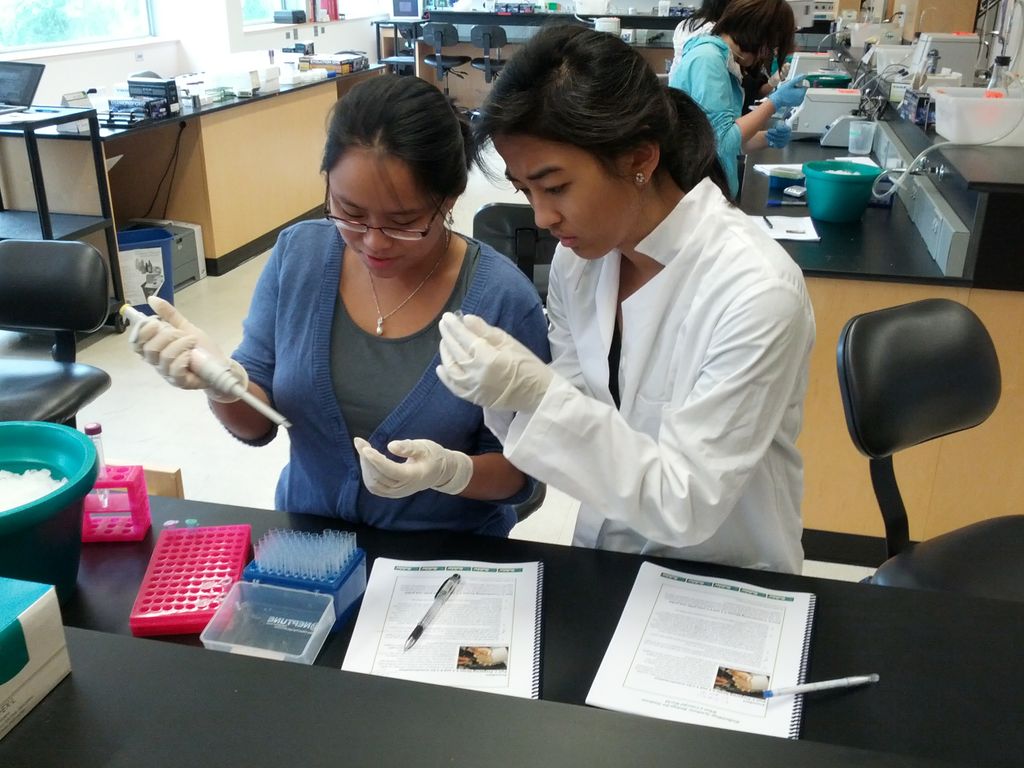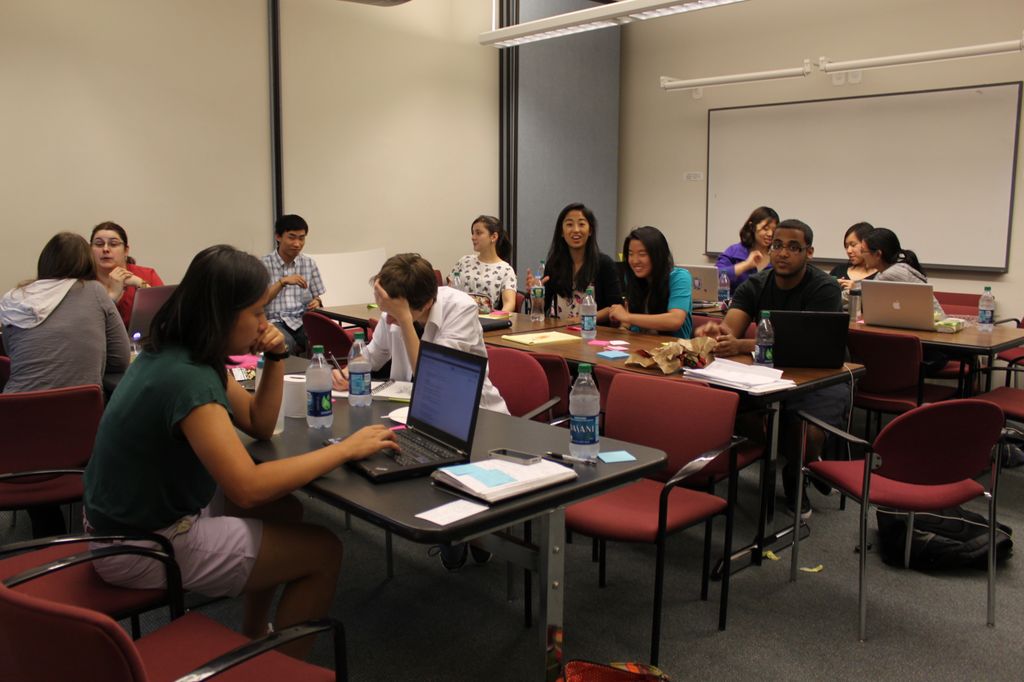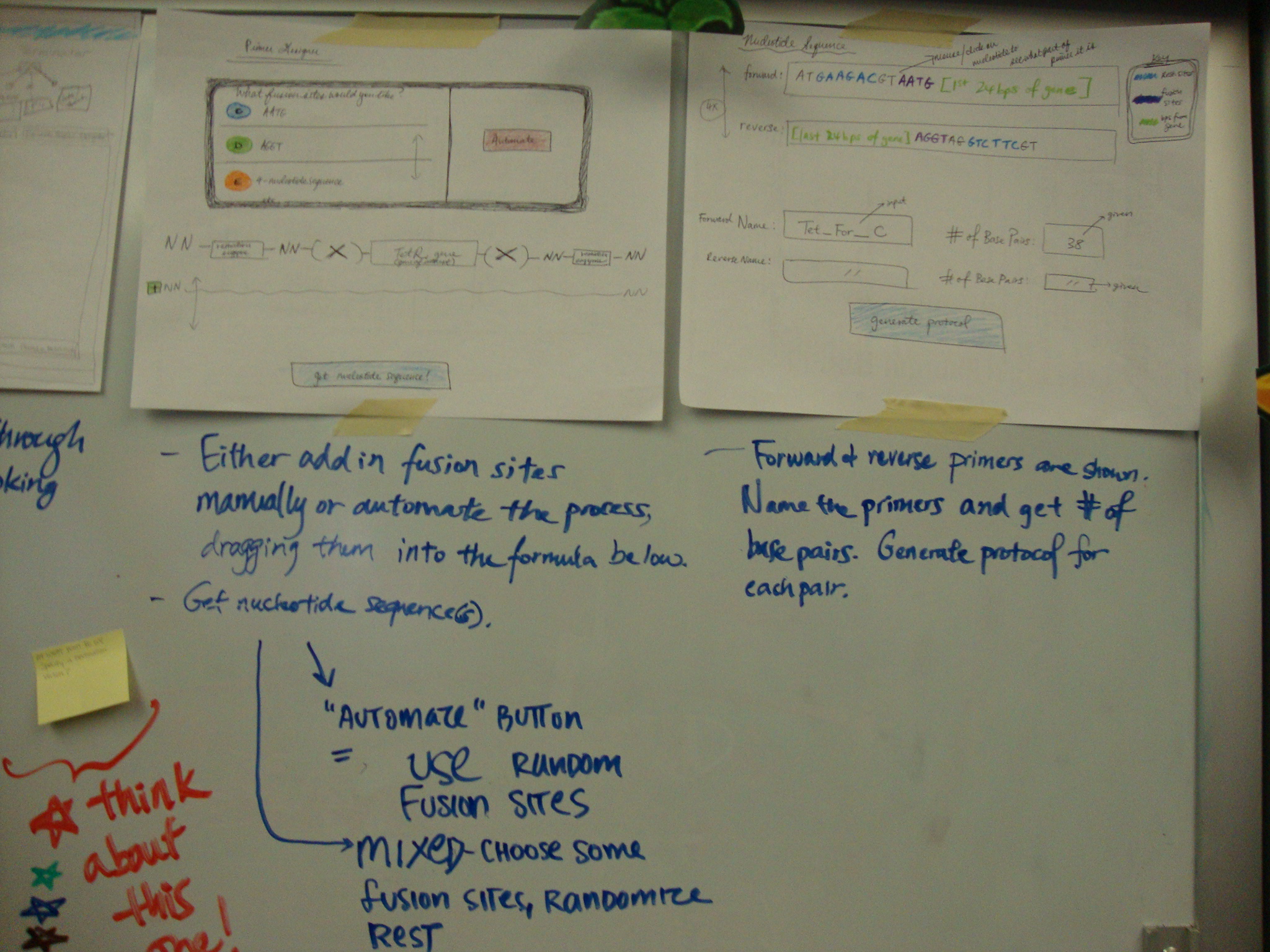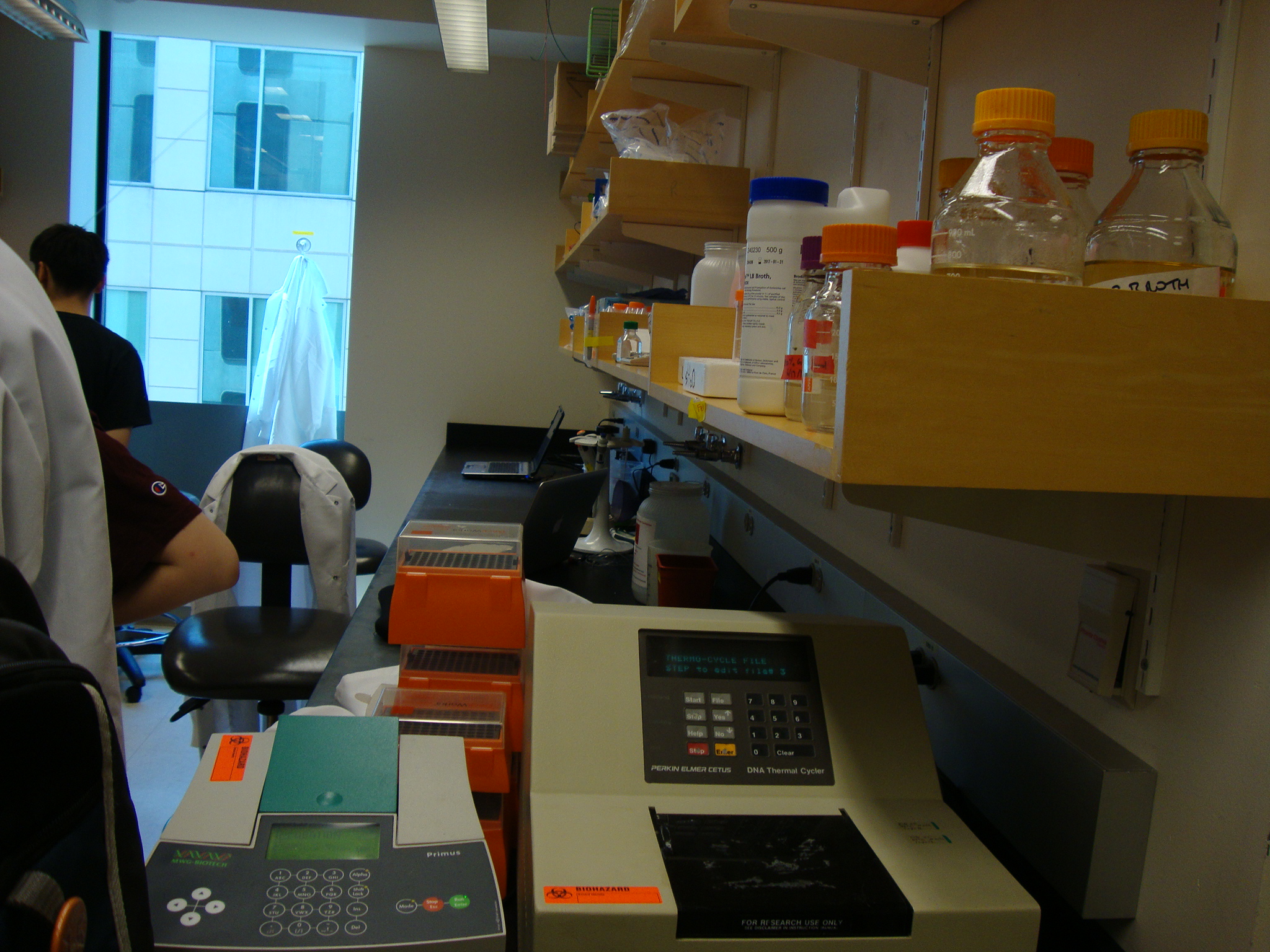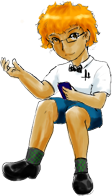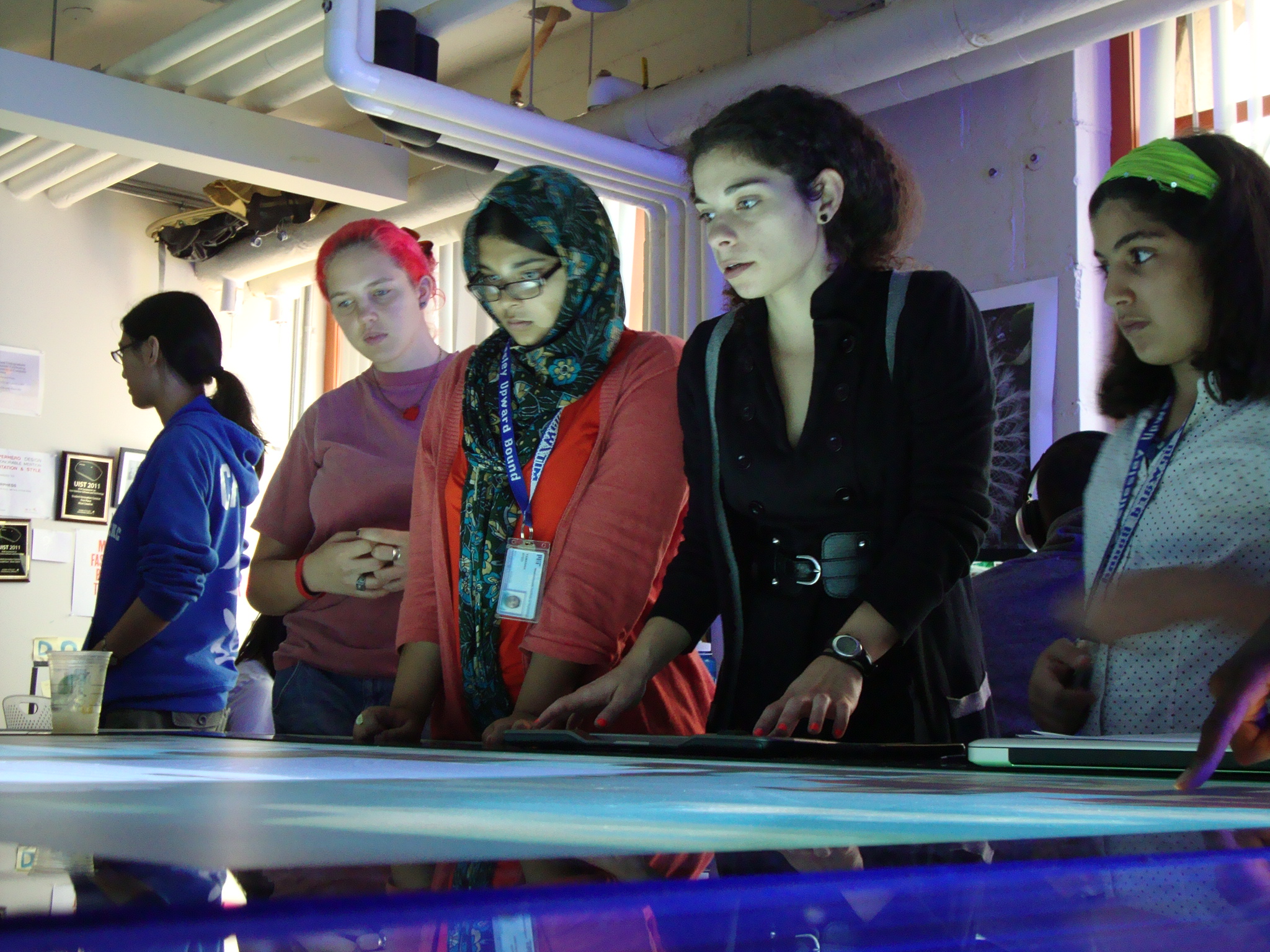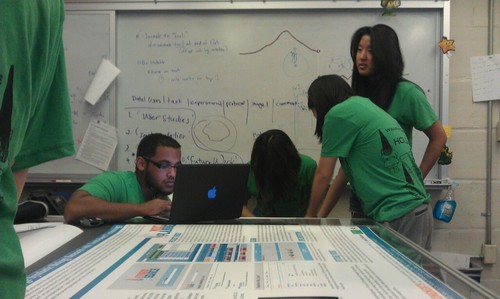Team:Wellesley HCI/Notebook/SiruiNotebook
From 2012.igem.org

Kathy's Notebook
Week of June 4th: Introductions in the Wet-Lab and Initial HCI Background Research
- Monday, 6/4: Jumping right back into research, after so much background readings over the weekend! Today we went to the Microsoft Research Cambridge to get a tutorial of Windows 8. It was particularly interesting because I hadn't had contact with C# nor Visual Basic before, but only got a crash course on it this morning. The new UI was especially interesting, especially the new metro-apps style and the start menu style change. There were also a couple of new gestures that were used with the tablet, such as swiping to corners or gesture-based log-in, that were particularly interesting. It would be great if we could take all these innovations and put them in the ELN design as well.
- Tuesday, 6/5: Today the Wellesley team went to MIT for a basic wet-lab training with Prof. Natalie Kuldell, who used to teach Genetics/BISC 219 labs at Wellesley. Those unfamiliar with synthetic biology received an introduction to the field, and we watched a videotaped presentation from the MIT '06 iGEM team, to gain a better understanding of how the iGEM competition format worked. Also, we were given an extensive introduction to what is expected in the human practices portion of the iGEM competition, and another introduction on doing interdisciplinary research (the different perspectives between engineers and lab scientists).
- Even better, after that we were able to participate in two different basic wet labs, one that is based on the Eau d'Coli lab, and another lab in creating beta-galactosidase assays. My lab partner, Consuelo, and I both realized that the experience was immensely valuable and incredibly eye-opening.
- We both agreed that several factors led to efficient completion of an experiment: labelling, following instructions, and communicating. We ran into problem again and again when we repeatedly mislabeled the tubes and confused our reagents, forcing us to restart repeated. We also found it at times challenging to follow the instructions in the format they were written in, simply because while reactions were happening we didn't have time to both read multiple paragraphs and pipette every 15 seconds. The wet-lab experience was eye-opening, and made us realize if the ELN is to be implemented that several features, such as highlighting, and labeling tools, among many others, needed to be added.
- Wednesday, 6/6: Today my group- Kara, Nahum, and I- started working on a powerpoint presentation in preparation for the brainstorming meeting with Orit tomorrow. We are working on researching past research in development of ELNs, and dividing up functions based on modality. Casey and I are also looking up research related to microinteractions that can be performed on the beast. We are particularly interested in Sifteo cubes and PaperLens.
- Thursday, 6/7: Today we had a meeting with Orit on things we learned about the ELN, and presented to her in a format of a Powerpoint. Since this is a preview of things we will be presenting about on Monday, the meeting was rather short. Orit suggested that we focus more on things having to do with troubleshooting, and features that can be added to the ELN that deal with visualizing troubleshooting in the lab.
- Friday, 6/8: Casey and I had a meeting with Orit today about microinteractions. Orit suggested that we look more into sifteo cubes as it might be used in the art project for the future, and that we should also focus on interactions that can be done on the bezel. A lot of the research that we thought weren't "feasible" might actually be more realistic than we previously thought- the beauty of HCI!
Week of June 11th: Interviews, Background Research, & Brainstorm Sessions Galore
- Monday, 6/11: Today we visited BU today and finally met the wetlab members, Shawn and Monique. Wendy, Casey, and I did a presentation on the basics of HCI, and also did brainstorming for the development of the ELN. We covered some ideas we had for the ELN, microinteractions on the beast, and the art project, compiled from our presentations last week. In return, Traci did a presentation/crash course on topics in biology to be covered this summer in the lab, as well as the MoClo method, which will be the main focus of the wetlab team this summer, as they will be using it to characterize parts.
- Tuesday, 6/12 & Wednesday, 6/13: These two days we had a massive-scaled brainstorming session. Our lab took over one of the physics classrooms upstairs, and taped poster-boards to the walls. Then, we divided up the groups based on projects covered: art project, semantic search, ELN, and Beast, and then go to work on brainstorming. Not only did we draw all over the boards, but we also wrote down on sticky notes comments and concerns, and then shared them with the rest of the team. The upside was that we threw around a lot of ideas, but the downside was that there were a lot of ideas to digest, and no established way to organize all the ideas, so some ideas that might not be essential now, but come to good use later were laid aside. There were a lot of information thrown at us today; I think we might need a few days to digest everything, but we do not have the luxury of time... Also, we did a short interview with Professor Kuldell today, but I think we might need to talk to her in the future when we have a better idea of what exactly to ask her in terms of UCD.
- Thursday, 6/14: Today we attended a talk by Tamara Hendrickson from Wayne State University on bioethics and working in academia. It was especially insight, and made us realize that regulation and training and organization all come into HUGE play when working in a wetlab. I think it would be great if we had the chance to interview her later on, and ask specific questions about troubleshooting in the lab, as well as more about bioethics in general.
- Friday, 6/15: Today we talked to Professor Arumainayagam (Chris A) from the Chemistry department, and interviewed him on a variety of topics, from development ideas on the ELN, to visualizing troubleshooting trees, to recording citations for papers, to managerial tools in his lab. We also talked to him about a variety of lab-organizing softwares and tools that are used in his lab. Chris A suggested that we look more into Quartzy, because his lab plans on using this tool for management in the lab. He gave us a lot to think about, as we realized that the concerned between his research and say, Traci's research, are oceans apart, but we needed to design tools that may be used by both for organizing their labs. Also, Chris A mentioned that Windows 8 was not very intuitive to him; perhaps that's something we also need to think about when designing things for synthetic biologists- there always has to be a balance between cutting-edge technology and design, and what people deem comfortable and intuitive. We need to think about all of these problems when going to do design the ELN.
- Also, because G-nomeSurfer was on an "ocean" theme (thus, the surfer board), it might be a "cute" idea if we renamed the ELN the PLOTBox (Personal Lab Organizational ToolBox), because it seems to compromise of several tools used for organization, including a presenter function on the Beast, a notebook component, and an organization component used in-situ in the wet lab. PLOTBox also just makes me think of sandcastles and shovels, so that'll go nicely with the beach theme...
Week of June 18th: Paper Prototyping the MoClo Planner Design
- Monday, 6/18: Today Kara and I interviewed Professor Sequeira. It was a very informative interview. Professor Sequeira gave us a lot of tips on how to visualize a troubleshooting tree, and how her team graphs progress when they are doing a long-term research project. Also, she gave us a lot of suggestions on features to add for the ELN, or should I say, the PLOTBox. The next thing we need to do is transcribe the interview, and focus on designing the MoClo planner.
- Tuesday, 6/19- Wednesday, 6/20: I spend almost all day reading the MoClo paper and trying to understand how to visualize fusion sites and restriction sites for the MoClo planner- this thing is much more complicated than I thought... Orit also asked us to look up additional information, such as related research, to design the MoClo planner.
- Thursday, 6/21: The team paper-prototyped the MoClo planner using Balsamiq, and we started to storyboard it. There will be a primer designer incorporated into the design, as well as access to fact sheets and related research. It'll be similar to gnome surfer, but instead of extended desktops, the levels are vertical "shutters". On the left is a picture of what the first panel would look like.
- Friday, 6/22: I transcribed the interview with Professor Sequeira, which took a very long time, with annotations. Next week, the goal is to make a video for the MoClo planner after we've refined the details, and then send the video to Traci for evaluation before we dive in and start implementing our design.
Week of June 25th: FInalizing the MoClo Planner Design & Introduction to Eugene
- Monday, 6/25: Continuing interview transcriptions; between the two interviews so far, there are a lot of material covered. Nahum, Kara, and I started making a refined version of the MoClo planner for the video, and talked more in details about the transitions. There is a huge difference between what we designed for the Balsamiq prototype, and what is designed as the paper prototype for the video. I think it might be a good idea for me to go back and document everything, for later.
- The idea of "shutters" that we've used is finally clarified. Ready for the video tomorrow!
- Tuesday, 6/26: Created a paper prototype video for the MoClo planner. The youtube link is: http://www.youtube.com/watch?v=IPr-D4vAGAM Doing this again reminded me of the process last year, when we did a video as well for G-nomeSurfer pro. I remember struggling a lot with narrations and talking about gestures while explaining the design. But now, making the video and creating the narration seems simple and almost second-nature. :)
- Wednesday, 6/27: We got some feedback from Traci today on the design for the MoClo planner. She would also like us to include in the primer designer component the reverse complement sequence created for the reverse primer. Also, I guess we also forgot some really important information for primer designer that we included in the Optimus Primer design last year- stuff like checking for different kinds of dimers, secondary structures, melting temperatures, etc. We will have to add that for later. Also, including the destination vector in the primer designer would be important, but that's something we'll focus on more when the primer designer is being implemented.
- Also, I started looking more into Eugene today; I think Orit wants us to look at Eugene and use that as part of the back-end for the MoClo planner.
- Thursday, 6/28: Continued looking more into Eugene and getting familiarized with the terminology. It seems that there is great flexibility in the language when it comes to syntax and definition. Something to focus on for the future, though- do "permute" and "product" really do what we think it does? It seems that permute might be useful for creating Level0 and 1 modules for the MoClo planner.
- Friday, 6/29: We met the MIT 2012 iGEM team today, and had social hour with the BU team as well. We went to an interesting physics lecture talk by Professor Walter Lewin, which was taped by NHK, the Japanese national broadcasting station. Members of the team visited the MIT iGEM wet-lab. We'll be back to visit team meetings in the future as well!!
Week of July 2nd: Understanding Eugene Code and Generating Permutations
- Monday, 7/2: I continued looking into Eugene, and reviewed the Optimus Primer code from last year. I'm anticipating getting into the nitty-gritty details of the coding soon, but understanding the primer designer code is proving to be difficult. The importance of commenting code cannot be understated right now.
- Tuesday, 7/3: Started working today on the rules and definitions needed to create a Level 1 module. This should be really interesting since I'm not familiar with C# nor Java nor Eugene yet. But I'm learning, even if the curve is rather steep...
- Wednesday, 7/4: Happy 4th of July! Kim, Kara, and I saw "The Amazing Spider-Man". There was a very cool tree visualization in one of the scenes that could totally be applied to our troubleshooting tree. It's interested how a lot of the things mentioned are already feasible in the field of HCI. Even better? "Cross-species genetics"... synthetic biology?
- Thursday, 7/5: Finished the Level1 module rules for Eugene. I'm fiddling around with the C# code for displaying the permutations by referencing the primer designer code we were working with last year, but having some difficulties. I think Casey and I might need to sit down and figure out what exactly is happening before I have a mental breakdown...
- Friday, 7/6: I sat down with Casey and slowly got introduced to the C# code for the Eugene module. We ran simulated data through Eugene and were able to make to print the codes in the command window. I talked to Ernst; the Eugene code will be updated soon, and we can view the sample code later, since it seems we need examples of Eugene in use. Next step: work on figuring out how product/permute works in the Eugene code.
To do for next week: Start parsing real data for feeding into the C# code, get Eugene to work, contact more PIs/post-grads/grads/profs for interviews on troubleshooting, start working on things for L2 module and primer designer with the background info Traci gave us, and contact other iGEM teams for observations/participation.
Week of July 9th: Integrating Real Data/Combining Front & Back Ends of the MoClo Planner
- Monday, 7/9: Consuelo, Casey, and I visited the MIT iGEM team and sat in on a morning wet-lab meeting today.
- Initial observations: We made observations on how the space restricted/augmented conversation and group interactions. Also, we looked at the variety of visual aids that were used by the PIs and students in the presentations. We also paid careful attention to conversations on troubleshooting techniques, and noticed several trends. It would really great once we're done with the MoClo planner that the MIT team come and test it out at Wellesley.
- Also, we started using the product and permute functions on Eugene. It seems that product and permute do not actually work the way we want them to for Level 1 modules. We want variations of concrete parts in the same order, replacing the absDevice(prom, RBS, CDS, term) pattern with real biobrick parts. However, permute changes the order of the parts so that the absDevice would have variations of (RBS, prom, term, CDS) or (term, RBS, CDS, prom), etc on the inside. This function will be extremely useful once we get to creation of Level 2 modules, but it is not pertinent to creating Level 1 modules.
- Tuesday, 7/10: Started fiddling with parsing real data. Somehow it's really difficult retrieving RBS data from the Registry! Do you search "RBS", their family names, or something else all together? What if the RBS doesn't have a family it belongs in? Nicole and Veronica have been working on semantic search for a while, and used their skills to also mine the Registry for pertinent information for the MoClo planner. However, as a result of using different parameters to classify different backbone parts, the rules that I wrote earlier for Eugene must now all be redefined. For example, I realized today that instead of creating 4 separate categories of promoters (constitutive, hybrid, repressible, inducible) that the promoter type can just be defined as a property" of promoters inside of a promoter type. The same pattern can also be followed for RBS, CDS, and terminators.
- Wednesday, 7/11: Consuelo, Wendy, and I sat in on a wet-lab meeting at BU. This week BU is focusing on creating their level1 modules, and Traci ordered a record-breaking 128 primers!! Back in the comp lab, we are working with Eugene still; with a lot of help from Casey I finally was able to parse some fake data, and get that to print out. The next step would of course be to use real data. But as a result of the parsing, I realized that a lot of the Eugene rules I had written had to be reworded.
- Thursday, 7/12: We worked on integrating my code with the front end done by Kara and Nahum. We decided that since permute nor product does what we thought they did, we should only use "permute" in Eugene for Level2 modules, and that for Level1 modules we create only a nested for-loop. Today I worked on integrating that into the MoClo Planner design, but as usual, ran into a lot of problems with syntax. We wanted to interview Professor Beers today, but there was a conflict and the interview is delayed to another time.
- Friday, 7/13: Starting to work on the backend behind Level 2, especially on Eugene. Things are especially interesting because creating a hybrid device might not work the way we thought in Eugene. So far, to test hybrid device functionality, we are creating four abstract devices with the same non-specific backbone parts, and then permuting them once they are all defined to be a single hybrid device. The problem is, will the permutations show the differences between the pieces of the hybrid device?
- So far, permutations are working- we can create 720 permutations of a level2 device from 6 abstract level 1 devices; this can be done by defining the abstract devices with the same parts inside (prom, RBS, CDS, term) while they are all abstract, and create a hybrid device composed of all 6 abstract devices. Then, the permutation is of the abstract devices inside the hybridDevice, which come out at 6!, or 720 permutations.
Week of July 16th: Generating Permutations on the Front End & More Interviews
- Monday, 7/16: We started generating text files of the permutations from Eugene, and then Consuelo and I sat down and started parsing the files and then integrating the files into the EugeneModules code, which is the front end that Nahum and Kara have been working on. I had to go back and redefine some of the rules as well as change names (e.g. "absDevice to absDevice1") for permutations to be generated. Tomorrow we will focus on generating and displaying correct Level 2 permutations on the MoClo planner. It's really good that now the front and back ends are getting merged together! Also, today we started planning for the CS/Math department presentation that we have to do on Friday.
- Tuesday, 7/17: Kara and I sat down today and started working on generating real permutations on the MoClo planner for Level 2, with the text files that we pulled from Eugene. We ran into some trouble when some parts of the text files were parsed incorrectly (again, the difference between "absDevice" and "absDevice1") but we successfully fixed that issue. We tested up to 4 permutations, but not 6, which is the maximum required, according to Traci. Also, we fixed several "minor", but really important issues in the long run, such as checking for duplicates in parts generates for L0, highlighting the permutations that are selected for each level, and some bugs with switching back and forth between automatically generated permutations and manually generated ones. Since tomorrow is beach day, we worked extra hard so that tomorrow can be relaxing!
- Wednesday, 7/18: Beach day. I stayed in the lab and worked on getting through the Google power search classes and generating questions for the interview with Professor Hendrickson on Friday. Also, I modified the powerpoint presentation for Friday, and finally figured out what I should talk about for Eugene, which is used for part of the back end of the MoClo planner, and thus is not as visually "flashy" as some projects that are in the lab.
- Thursday, 7/19: Today Upward Bound students came into the lab, and Consuelo and Kim did a demo of the Beast, SynFluo (as the art project with the Sifteo cubes is now called). I worked on creating an iMovie video for the presentation on Friday demonstrating MoClo in action- it's not going to be one we show at iGEM, of course, but more practice with iMovie is always good!
- Friday, 7/20: Today, I interviewed Professor Tamara Hendrickson, of Wayne State University about her opinions on the development of the ELN, using the BEAST as a tool for collaboration in the lab, and also in general about organization in the wet lab. I'm amazed that even after brainstorming, interviewing students, talking to professors, PIs, and graduate students that there are still innovative features to be added to the ELN. I think it might be wise if the next step we talk to less engineers, and more scientists about troubleshooting, and also talk to people who are in a related field to synthetic biology, just so we can understand better many different aspects of human practice and ethical concerns that we haven't covered before. For example, if we talked to a wet lab instructor and then talked to a lecturer about features to include in our design, their perspectives- including their concerns, expertise, and what they think are "necessities" in the design- are so different that they both serve to enrich our designs further.
- Also, today we started recruiting for the initial stages of testing for next week. I was amazed than in half an hour we were able to schedule 3 pairs of participants for Tuesday, all whom have taken either AP biology or BISC 110! The summer research program at Wellesley, and the enthusiasm of the students, amaze me.
- To do for next week: Demo, Demo, Demo...Design usability test first to be used for lab interns not directly involved with MoClo Planner on Monday, then for Wellesley students usability test on Tuesday, then talk to Traci on Wednesday to get her feedback when we demo to BU, and finally test out the MoClo planner with MIT students on Friday. While all of this is happening, also talk to a variety of experts related to the field of synthetic biology, and start refining questions for interviews!
Week of July 23rd: Demo Week @ Wellesley, MIT, and BU
- Monday, 7/23: Over the weekend I wrote a detailed user scenario to be used for the round of initial testing at Wellesley. Because not a lot of students are familiar with the modular cloning process nor about synthetic biology as a field, I had to give a summary of both before writing the task. Summarizing synthetic biology as a field in a paragraph is no easy feat, and I definitely struggled a lot with writing this, but it's made me realize that this could help us later when we are pulling together everything for the summer abstracts and posters next week.
- We've managed to get half a dozen Wellesley students with BISC 110 (intro Cell Bio) or AP Biology experience to come and test our software tomorrow! It should be a crazy day tomorrow, setting up the demos in room 160 across the hall while also the Upward Bound Demos are happening.
- Tuesday, 7/24: The first day of the user studies testing begins! We had three sessions for Wellesley students, each of which consisted of a pair of students. Consuelo and I sat in for usability studies for most of the day, but also Nahum and Kara helped out.
- Wednesday, 7/25: Today two things were happening: Kara, Nahum, and Veronica worked on fixing bugs from yesterday's usability studies, which were quite a few. In the meanwhile, with every testing I updated the scenario and started editing the questions to make them more clear and intuitive for the users. Also, because the summer poster session is coming up, we started designing the poster and also pulling together text for the poster. I think having a poster design inspired by the MoClo planner (shutter and element menus) and colors inspired by it might be useful.
- Thursday, 7/26:Round #2 of the user studies at Wellesley started today! We had some bugs from Tuesday's study that were fixed yesterday, but today we are hoping to catch more bugs. Also, we attended a grad school panel today that informed our understanding of the grad school process. Even though there weren't any synthetic biologists (evolutionary biologists and computer scientists were present, as well as a biochemist), their experiences informed me greatly.
- Friday, 7/27: MIT user study day! Nahum, Consuelo, and I went to go visit the iGEM team at MIT this week and tested out the MoClo Planner with four pairs of students. It was definitely still a challenge moving Uppy, but significantly easier than doing the studies with the BU teams last year with the bulky old surfaces!
Week of July 30th: Science Center Poster & Presentation
- Monday, 7/30: Continued working on the abstracts for the science center, and finished them today about two minutes before the deadline! (Consuelo, Kara, and Veronica went to the BU user study today since I had a lot of writing to do.) Also Wendy and i went to a Q&A session about our summer research experience hosted by Cathy Summa, director of the Science Center Research Program. We talked about our experiences doing research in biology, neuroscience, and interdisciplinary computer science research. Talking about the experience made me realize how much I treasure my time doing research in the HCI lab, and how that's completely changed my Wellesley experience and gave insight to my job search in the future.
- Tuesday, 7/31: The main focus for today is the poster for the science center summer research program. Since everyone else is busy coding and refining things we've picked up from the three sets of user studies, I'm in charge of making the MoClo/Synbio Search poster. Today the focus was really on finding the right words to put on the poster, and iterating both the design and the content of the poster. It's been a very, very long day and I'm only on version 9 of the poster...
- Wednesday, 8/1: Still working on the poster, but making a lot of progress! The content of the poster is mostly done- I just had to do a lot of formatting and small, detailed editting before we are to print it this afternoon. :) I think everyone is supposed to be also working on what they need to say for the science center poster session.
- Thursday, 8/2: Summer poster session was today! Our lab shirts also arrived today! It was super exciting getting to try the green things on- the design was really cute, and the shirts themselves extremely comfortable. It was definitely interesting looking at our research and the amount of progress we've made over the summer and compare it to my peers' research. It made me realize how much collaboration and interdisciplinary dialogue occurs in this lab for the project to happen, and also made me realize how grateful I am for being to participate in cutting-edge synthetic biology and computer science research.
- Friday, 9/3: Looking up background information and pulling up relevant writing to MoClo Planner today for Orit's ITS Demo. I have to change the design and evaluation sections of the ITS Demo paper and make it more comprehensible for computer scientists and not synthetic biologists. It's interesting that now I have to explain our system to others in the field of human-computer interaction, and that the jargon, lingo, and focus of our conversation shifts drastically for our target audience. The focus is no longer on the support for the biology side, but on interactions, gestures, the intuitive and efficiency of the MoClo Planner system.
Week of August 6th: ITS Paper & Christine Loh Interview
- Monday, 8/6: Today, Linda, Casey, Consuelo, and I (the only ones left D:) worked together in creating demo videos for ITS, including a cute video of SynFlo and another video for the MoClo planner. Also, we did some background research to help Orit with the ITS paper, including pulling together background information on the MoClo planner- I'm glad that the abstracts and things for the summer research poster are put to good use!
- Tuesday, 8/7: Today, mainly Consuelo and I worked on preparing and perfecting a great demo video for ITS, as well as helping Orit with the MoClo and SynFlo papers for ITS. A lot of proof-reading and editing papers today, but the papers got submitted! Yay!
- Wednesday, 8/8: Unfortunately I did not have a very productive day today- I had to upgrade my operating system to Mountain Lion, and that took a very long time. The next things I have to work on are the abstracts for the IGEM website and the preliminary responses for the safety page. I think our responses will be very interesting considering that we are a software team, but we designed our projects with wet-lab teams in mind. I think I might have to go back and look at some recent articles and policies regarding safety in synthetic biology before I jump into this question.
- Thursday, 8/9: Packing, and also writing....
- Friday, 8/10: Today I did an interview with Christine Loh, who is a research technician at Sirtris over in Boston. We had a very informative and interesting discussion regarding development of an electronic lab notebook, but also pertinent organization software tools used for collaboration and data-sharing in the lab. We also talked extensively on biosafety and biosecurity.
 "
"

